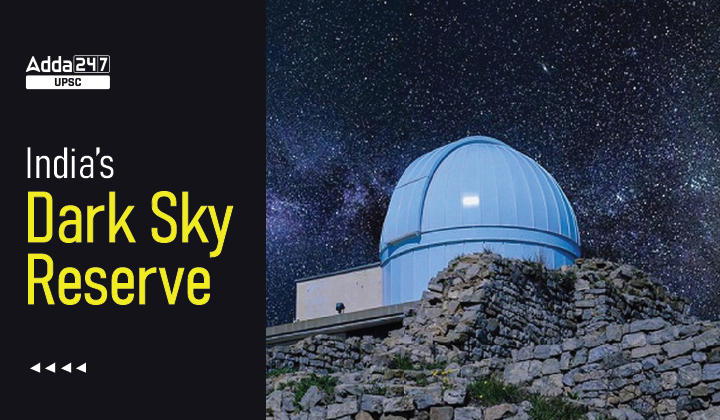Table of Contents
India’s Dark Sky Reserve: Relevance for UPSC Exam
General Studies III- Achievements of Indians In S&T, Awareness In The Fields Of IT, Space, Computers, Robotics, Nano-Technology, Bio-Technology, Pharma Sector & Health Science
India’s Dark Sky Reserve: Context
- The union territory of Ladakh will host India’s first Dark Sky Reserve which will be set up in Hanle area in the next three months.
- The Dark Sky Reserve is being built as part of Ladakh’s high-altitude Changthang Wildlife Sanctuary.
What is Dark Sky Reserve (DSR)?
- Definition of Dark Sky Reserve: The International Dark Sky Association (IDSA) defines an international dark sky reserve (IDSR) as “a public or private land of substantial size (at least 700 km², or about 173,000 acres) possessing an exceptional or distinguished quality of starry nights and nocturnal environment, and that is specifically protected for its scientific, natural, educational, cultural heritage, and/or public enjoyment.
- A dark sky reserve requires a “core” area that has clear sky without any light pollution, which can enable telescopes to see the sky in its natural darkness.
India’s Dark Sky Reserve: Ideal Location
- Ladakh is ideal for long-term observatories and dark-sky sites because of its large arid area, high elevation, and sparse population, extreme cold and minimum temperature drops to minus 40 Degree Celsius.
- The Changthang wildlife Sanctuary, the DSR site is situated around 4,500 metres
- The Department of Science and Technology and Indian Institute of Astrophysics (IIA) in Bengaluru are providing support for the facility. The IIA already manages the Indian Astronomical Observatory (IAO) complex in Hanle, Ladakh.
India’s Dark Sky Reserve: International Standards
- International Dark Sky Association’s Recognition: The IDSA recognizes and accredits dark-sky areas worldwide, in three categories. The Mont Mégantic Observatory in Quebec is the first such site to be recognized (in 2007) as an International Dark Sky Reserve.
- Individuals or groups can nominate a site for certification to the International Dark Sky Association (IDSA). There are five designated categories, namely International Dark Sky parks, communities, reserves, sanctuaries and Urban Night Sky Places.
- The certification process is similar to that of a site being awarded the UNESCO World Heritage Site tag or getting recognised as a Biosphere Reserve. Between 2001 and January 2022, there have been 195 sites recognised as International Dark Sky Places globally, the IDSA said.
- IDSA recognized Natural Bridges National Monument in Utah as the world’s first International Dark Sky Park.
- In 2015, the IDSA introduced the term “Dark Sky Sanctuary” and designated the Elqui Valley of northern Chile as the world’s first International Dark Sky Sanctuary. The Gabriela Mistral Dark Sky Sanctuary is named after a Chilean poet.
India’s Dark Sky Reserve: India’s Objective
- The primary objective of the proposed Dark Sky Reserve is to promote astronomy tourism in a sustainable and environment-friendly manner. Scientific methods will be used here to preserve the night sky from ever-increasing light pollution.
- With metros, cities and peripheral areas experiencing light pollution and remaining constantly lit up, there are diminishing areas that offer a view of clear skies on cloudless nights.
- In the pilot phase, the Indian Institute of Astrophysics (IIA), has procured ten small and easy-to-handle telescopes and light-reflecting shields. IIA’s scientists and outreach experts will identify locals and train them to use these telescopes.
- This will include basic sky gazing, identification of constellations, and locating the pole star, among others. These telescopes will be installed at the homestays, which is a popular option for tourist accommodation in Ladakh.
Conclusion
- The Dark Sky Reserve is likely to boost Astro tourism in India where there has been no such reserve. Once set up, the reserve will be the highest-located site in the country for infrared, gamma-ray, and optical telescopes.




 TSPSC Group 1 Question Paper 2024, Downl...
TSPSC Group 1 Question Paper 2024, Downl...
 TSPSC Group 1 Answer key 2024 Out, Downl...
TSPSC Group 1 Answer key 2024 Out, Downl...
 UPSC Prelims 2024 Question Paper, Downlo...
UPSC Prelims 2024 Question Paper, Downlo...
